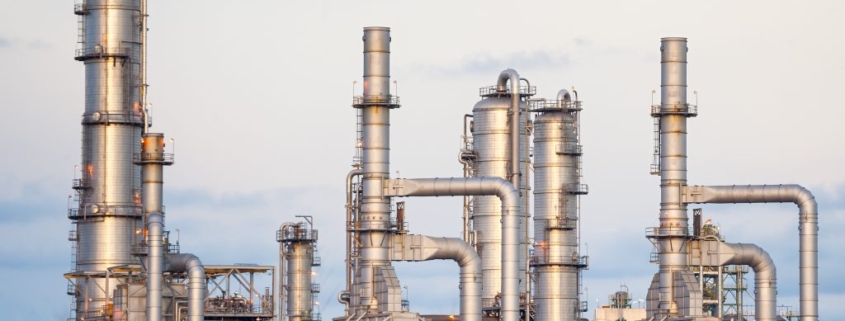Typical Corrosion Resistant Alloys (CRAs) for Chemical Industry Applications: Guidelines
Corrosion Resistant Alloys (CRAs) – The Best Corrosion Resistance
Nickel and nickel alloys exhibit good corrosion resistance in various wet, corrosive environments, which is common in the chemical and energy industries. Nickel is a multi-purpose corrosion-resistant metal, and as an alloying element, it has good metallurgical compatibility with various metal elements. It is the primary metal element in many binary, ternary, and complex nickel alloys. It has unique corrosion resistance when dealing with the corrosive environment of the modern chemical industry. In addition, the anti-corrosion performance also depends on the chemical composition, metallographic structure, corrosive medium properties, and the contact surface between the alloy and the medium.
Let’s take a brief look at three crucial nickel-based alloy elements from an alloy perspective:
The first is Nickel. Pure Nickel is characterized by excellent corrosion resistance against various corrosive media (especially against caustic alkali, halides, and high concentrations of organic compounds), suitable mechanical properties, and high thermal conductivity. Unalloyed Nickel is mainly used in the production and subsequent processing of sodium hydroxide, where optimal corrosion resistance is required. Therefore, the cathode of the electrolytic cell used in the ionic membrane caustic soda process is made of pure nickel sheets. The concentrate downstream treatment unit is also nickel-based. Austenitic stainless steel cannot be used in caustic soda evaporators, so pure Nickel is the first choice. Another application for pure Nickel is in solidified bed reactor vertical tubes in vinyl chloride monomer production. Chromium is another crucial alloying element for corrosion resistance, which is necessary to provide a stable passivation surface layer. Molybdenum is an alloy element second only to chromium in importance and can improve corrosion resistance against reducing media. Molybdenum and chromium are the most crucial pitting and crevice corrosion resistance elements.
Alloy 201
Alloy 201 is a pure nickel with a specified carbon content of no more than 0.02%. Its operating temperature is typically above 315°C (600°F). This material has been certified in pressure vessels with operating temperatures between -10 and 600°C (18 and 1112°F).
Alloy 400
Alloy 400 is a nickel-copper alloy with best-in-class corrosion resistance to a wide range of reducing corrosive media while combining good mechanical properties. Corrosion resistance is excellent in air-free hydrofluoric acid, neutral, and alkaline salt solutions. The alloy can be used for uranium refining and isotope separation in nuclear fuel production. It is a standard material for the concentration and crystallization of salt solutions, vinyl chloride monomer (VCM) production, MDI and TDI production, and petroleum refining. Alloy 400 is also used to make feedwater heaters, steam generator heat transfer tubes, jacketed pipes, and platform steel columns used in offshore oil and gas production. This material has been certified in pressure vessels operating between -10 and 425°C (18 and 797°F).
Alloy 600
This alloy has extreme resistance to intergranular corrosion and is exceptionally resistant to high-temperature corrosion cracking. It can handle dry chlorine and hydrogen chloride. In titanium dioxide production, this alloy makes almost all equipment that comes into contact with high-temperature chlorine or high-temperature titanium tetrachloride. In the chemical industry, this alloy is used in the production and processing of sodium hydroxide (caustic soda), ethylene, vinyl chloride monomer (VCM), the production of MDI and TDI, and the manufacture of dehydration towers in magnesium smelters. This material has been certified in pressure vessels operating between -10 and 450°C (18 and 842°F).
Alloy 690
Alloy 690 is a nickel-chromium-iron alloy with a chromium content of approximately 30%. Its most important application is in steam generator equipment for nuclear power plant pressurized water reactors, where it is used to make evaporator tubes, water chamber partitions, boot openers, and radial guides. Its high chromium content makes it particularly suitable for handling and storing strongly oxidizing media, such as the secondary processing of nuclear fuel. This material is exceptionally resistant to intergranular corrosion, fluoride-contaminated hot nitric acid corrosion, and corrosion cracking from oxygenated sodium hydroxide solutions.
Alloy B-2
Alloy B-2 is a nickel-molybdenum alloy with excellent corrosion resistance to reducing media, such as hydrochloric acid at different temperatures and concentrations and sulfuric acid at medium concentrations. In the chemical industry, applications for this alloy include processes using reductive chloride catalysts such as AICI3, as well as styrene, bisphenol A, chloroprene, and MDI synthesis processes (HCl is a by-product of the process) and acetic acid production. Because of its deficient carbon and silicon content, this alloy is resistant to knife-edge corrosion and selective corrosion in the heat-affected zone. In the 1990s, VDM strictly controlled the iron and chromium content, significantly improving the alloy’s processability. This material is certified in pressure vessels with operating temperatures between -196 to 400°C (-335 to 752°F).

Alloy 625
Initially developed for high-temperature applications, this nickel-chromium-molybdenum alloy is now widely used in the chemical industry and energy technology. It has high mechanical strength and good acid and alkali resistance and can produce thin-walled parts with good heat transfer characteristics. It has strong corrosion resistance to pitting, crevice, and intergranular corrosion. It is almost entirely immune to stress corrosion cracking caused by chloride, making it ideal for components immersed in seawater (as well as highly concentrated corrosive salt solutions and saltwater). The material, for example, can be used in potash fertilizer production. This alloy is used in the phosphate and phosphoric acid industry because it resists corrosion and attack by phosphoric acid slurries and superphosphoric acid containing higher impurities. Other applications include induced draft fans and agitators in flue gas desulfurization units. This material is certified in pressure vessels with operating temperatures between -196 to 450°C (-335 to 842°F).
Alloy C-276
Alloy C-276 is a nickel-chromium-molybdenum alloy containing a tungsten element. It has strong corrosion resistance to pitting and crevice corrosion, uniform corrosion, and stress corrosion cracking of various chemical process media (significantly reducing media). Sex. Due to its good corrosion resistance, mainly against reducing media (even in halogens), this alloy has become a real workhorse dominating various applications in the chemical industry. Applications for Alloy C-276 include plate heat exchangers operating at low temperatures in sulfuric acid production. Other applications (for example, VCM production) utilize the hydrochloric acid corrosion resistance of Alloy C-276. In addition, this type of alloy has good corrosion resistance to acetic acid at various concentrations and temperatures. It can be used in oxidizing acetic acid solutions, mixed acids with acetic acid and inorganic acids, and mixed solutions with inorganic salts, such as stainless steel. Unsuitable for chemical environments. The practice has proven that this material suits environmentally friendly technologies such as flue gas desulfurization. In such applications, this material is used extensively in flue gas inlets, scrubbers, dampers, agitators, ducts, etc. This material is certified in pressure vessels with operating temperatures between -196 to 400°C (-335 to 752°F).
Alloy C-4
Alloy C-4 is a nickel-chromium-molybdenum alloy that combines the excellent corrosion resistance of Alloy C-276 with improved stability due to significantly reduced ferrotungsten content. This material has a slower precipitation process and has more excellent post-weld corrosion resistance. This alloy is an upgraded version of Alloy C-276 developed by a European company. Its applications in the chemical industry include the preparation of fertilizers and pesticides as well as pharmaceutical intermediates and general organic and inorganic chemical production (including MDI and TDI). The titanium-free alloys supplied by VDM do not contain titanium nitride. This titanium-free alloy can be electrolytically polished to form a smooth, uniform, and durable metal surface, so it is widely used in the pharmaceutical industry and special working conditions, such as current delivery rollers used in the electrolytic galvanizing industry. This material is certified in pressure vessels with operating temperatures between -196 to 400°C (-335 to 752°F).
Alloy 22
Alloy 22 is a nickel-chromium-molybdenum alloy derived from Alloy C-276. The higher chromium content provides better resistance to oxidative corrosion. This alloy is recommended for manufacturing equipment for treating oxidants, contaminated hot sulfuric and phosphoric acids, other mixed oxidant solutions, acetic acid, acetic anhydride, and other contaminated organic acids. This material is certified in pressure vessels with operating temperatures between -196 to 400°C (-335 to 752°F).
Alloy 59
Alloy 59 is an advanced nickel-chromium-molybdenum alloy that exhibits excellent corrosion resistance under various oxidizing and reducing conditions that have been the limit of other nickel-chromium-molybdenum alloys. This material is used extensively in the most corrosive parts of flue gas desulfurization processes, such as flue gas inlets, absorbers, heat exchangers, dampers, fasteners, and welding filler metals. It has strong corrosion resistance to crevice corrosion of seawater-immersed components, making it an alternative to titanium, the manufacturing material for seawater-cooled plate heat exchangers. Other applications include organic synthesis, wastewater treatment, spent acid recovery systems, phosphoric acid processes, and acetic acid production.
This alloy has better corrosion resistance to hydrochloric acid than other nickel-chromium-molybdenum alloys and is suitable for producing VCM, MDI, and TDI. In addition, it is ideal as a construction material for all stages of hydrofluoric acid and aluminum fluoride production. This alloy has strong corrosion resistance to oxidizing and reducing media. Its ease of passivation and resistance to chloride corrosion in sulfuric acid solutions make it ideal for multi-purpose equipment required in producing fine chemicals and specialty chemicals—construction materials.
As a construction material for tank containers in transporting dangerous goods, Alloy 59 has the most diverse corrosion resistance properties. It can be used for the transportation of a variety of corrosive substances. Alloy 59 combines excellent corrosion resistance with excellent processability. It is the most suitable metal construction material for small structural parts where corrosion losses during operation are difficult to form, such as microchannel reactors and compact diffusion bonded exchangers. Heater. Its metallurgical stability is excellent, and no heat treatment is required after welding. The material has been certified in pressure vessels with operating temperatures between -196 to 450°C (-335 to 842°F).
Alloy 825
Alloy 825 is a titanium-stabilized nickel-chromium-iron-molybdenum-copper alloy with good corrosion resistance to stress corrosion cracking and moderate resistance to pitting and crevice corrosion. It is a traditional but versatile material that provides specific corrosion resistance in various process media, such as low-concentration phosphoric acid solutions, nitric acid, and sodium hydroxide, making it a standard material for moderately corrosive sulfuric acid applications. This material has been certified in pressure vessels operating between -10 and 450°C (18 and 842°F).
Alloy 31
Alloy 31 is a newly developed nickel-iron-chromium alloy containing 6.5% molybdenum austenite. It has strong corrosion resistance to pitting and crevice corrosion and is superior to traditional 6-Mo steel and Alloy Nickel alloys like 625-Nicrofer 6020 hMo. This alloy resists seawater pitting corrosion up to 90°C (194°F) and is highly resistant to sulfuric acid solutions (even highly contaminated ones).
Alloy 31 also performs well in phosphoric acid production and is in a demanding working environment. It is perhaps the most cost-effective material suitable for this environment. In the pulp and paper industry, this alloy is particularly suitable for use in chlorine dioxide bleaching plants. Despite the higher molybdenum content, this alloy shows corrosion resistance to nitric acid (intergranular corrosion test), comparable to Alloy 28-Nicrofer 3127 LC. Alloy 31 is also suitable for heat exchangers cooled by contaminated water, such as seawater or brackish water, at moderate temperatures. This alloy performs far better than Alloy 825 regarding Pitting Corrosion Equivalency (PRE) in airborne chloride media such as seawater. Therefore, it is widely used in the salt industry.
It has extreme corrosion resistance to the local corrosion of acidic chloride solutions, so it is increasingly used in flue gas desulfurization systems. In such systems, it is the material of choice for piping, damper injection volumes, and controlled shut-off systems operating under the harsh conditions of modern coal-fired power plants. This material is certified in pressure vessels with operating temperatures between -196 and 550°C (-335 to 1022°F).
Alloy 926
Alloy 926 is an austenitic iron-nickel-chromium-molybdenum-copper-nitrogen alloy similar to Alloy 904 L-Cronifer 1925 LC, but the molybdenum content is increased (about 6.5%) and about 0.2% nitrogen is added. Significantly improved corrosion resistance against pitting, crevice corrosion, and chloride-induced stress corrosion cracking. This material has firmly established its place in seawater and product piping systems, flue gas desulfurization units in thermal power plants, and the desalination and pulp and paper industries. Alloy 926 is also widely used in the concentration and crystallization of salt solutions based on chloride-contaminated media (e.g., sulfuric acid and phosphoric acid) at moderate temperatures and in producing fine chemicals. This material is certified in pressure vessels operating between -196/-10 and 400°C (-335/18 and 752°F).
Heat resistance, high temperature, high strength – Nickel alloys and specialty stainless steels
Heat-resistant alloys are specified for 550°C (1022°F)
Heat resistance of above high-temperature gases and combustion products. A protective oxide layer must be formed on the metal surface to achieve this heat resistance. Among the three elements that can create protective oxide layers: aluminum, silicon, and chromium, chromium has the broadest applications. The operating temperature of aluminum in an oxidizing environment can reach over 1000°C (1832°F). Adding small amounts of yttrium and rare earth elements such as cerium can increase the bond strength of the protective oxide layer. Adding silicon components is effective (mainly during the initial oxidation stage) because an oxide film can be formed quickly. Increasing the nickel content can increase the corrosion resistance to uniform carburizing gases and significantly reduce the corrosion resistance to sulfur-containing media. High-temperature and high-strength materials show better mechanical properties under long-term high load conditions, indicating better creep resistance and higher creep rupture strength (even above about 550°C (1022°F) under a high-temperature environment). However, in many applications, it is required to have high-temperature and high-strength properties and corrosion resistance against high-temperature gases and combustion products above 550°C (1022°F) (i.e., heat resistance as defined above).
Alloy 600
Alloy 600 is the recognized standard construction material for many industrial furnaces today. This alloy is exceptionally corrosion-resistant in nitriding, carburizing, and halogen environments. Due to its better creep strength, the solution annealed condition is recommended for operating temperatures above 700°C (1292°F).
Alloy 800H
Alloy 800 H is widely used as industrial furnace components, such as furnace fans. This alloy is an essential material in the petrochemical industry. It is used to produce ethylene cracking furnace pipes, headers, and pigtails in catalytic cracking units, cracking furnace components (for vinyl chloride, diphenyl, and acetic anhydride production), and at 600°C Transmission lines, valves, fittings, and other components operating in corrosive environments above (1112°F). This alloy also makes pipes and tube sheets used in styrene production. In addition, it is also used to build combustion furnaces.
Alloy 602 CA
Alloy 602 CA (2.4633) is a new high-strength, high-temperature material developed specifically for industrial furnace construction and the petrochemical industry. This material benefits from its high carbon and zirconium content and exhibits excellent mechanical properties and best-in-class resistance to oxidation and carbonation in high-temperature environments above 1000°C (1832°F). The primary carbide precipitation ensures its creep strength. Typical applications include radiant tubes, bright annealing muffle furnaces, radioactive waste vitrification molds, methanol, ammonia synthesis, enameled furnace internals, and pigtail tubes. This alloy also makes rollers for continuous annealing furnaces, operating primarily at temperatures between 1100 and 1200°C (2012 and 2192°F). In addition, Alloy 602 CA has excellent resistance to metal powdering, so it is widely used in related processes in the petrochemical industry. It also produces prefabricated parts for iron ore direct reduction plants.
Zirconium
Zirconium is a 21st-century metal material after titanium. Similar to titanium, a thin, dense oxide protective layer can quickly form on the surface of zirconium metal, making this material highly acid-resistant. It can resist oxidizing acids such as nitric acid and concentrations of up to 60% phosphoric and 70% sulfuric acid. However, performance will vary depending on impurities in the environment. It is also corrosion-resistant to liquid hydrochloric acid. Zirconium is also used in chemical processing conditions where nickel alloys or stainless steel cannot handle it. Zirconium is easy to process.
Zr 700 and Zr 702
In addition to its applications in the nuclear industry, where its low thermal neutron absorption coefficient is a particular advantage, zirconium is also used in chemical processes where nickel alloys or stainless steel cannot cope, including hydrochloric acid, sulfuric acid and mixed acids of nitric acid, formic acid, and acetic acid. Other applications include urea production, highly alkaline environments, salt solutions, and other corrosive organic solutions.
Zirconium is corrosion-resistant to various concentrations of hydrochloric acid at temperatures well above the boiling point. It shows excellent corrosion resistance in sulfuric acid concentrations up to 70% and is also resistant to corrosion at low concentrations of sulfuric acid at temperatures above the boiling point. In addition, today’s production technology can already process and produce extensive equipment and explosion-proof coated zirconium tubes, heat exchangers, reactor vessels, pipes, and auxiliary equipment.
Its typical application is in the main reactor for producing acetic acid in a carbonylation process, where the exothermic reaction occurs at temperatures of 180 to 200°C (302 to 392°F). Zirconium is also used to produce the heat exchanger and the first column.
Zirconium is also used in the sulfuric acid pulp digestion process, mainly due to its corrosion resistance to high-temperature sulfuric acid. Zr-702 is a conventional industrial-grade alloy (oxygen content max. 0.16%). Zr-700 is a low-oxygen alloy (oxygen content max. 0.10%) used in explosive composites due to its flexibility. Zirconium has been certified in pressure vessels operating between -10 and 250°C (18 and 482°F).




